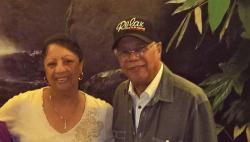I regret never learning how to hit a great forehand, but I’ll never regret watching Pancho Segura do that and more.

Courtesy: Amazon
They called my favorite tennis player “Little Pancho.” Maybe that was because “Pancho” Segura stood 5 ft 6, while his younger rival, “Big Pancho” Gonzales, was 6 ft 2. I watched “Little Pancho” play in 1948 at Washington, DC’s old Uline Arena. From that day on I was hooked.
I tried learning the basics of the game from really good tennis players at Banneker Jr. High, but soon realized that I was going nowhere. I bought the heaviest racquet I could find, thinking that would give me added power. Boy, was that a mistake! Those wooden racquets were all too heavy for me.
Then I read about a pro tennis star who hit his forehand shots with both hands on the racquet. Wow! He used a two-handed forehand! Maybe that was my answer. I had to see this Pancho Segura for myself.
I was in for a surprise. He was really short with bow legs caused by a childhood bout with rickets. No matter, “Little Pancho” was all over the court, smashing two-handed forehands that sounded like rifle shots in an enclosed arena. I soon learned that Segura’s two-hander was the fastest forehand of all his peers.
“Little Pancho” had a memorable tennis career. Born in 1921 in Ecuador (he’s 95 today) Francisco Olegario Segura chalked up a long list of major singles and doubles titles, both amateur and pro. The Professional Lawn Tennis Association ranked him #1 in the world in 1942.
He stopped playing competitive singles in 1970 at the age of 49 and, then, started coaching film stars at the Beverly Hills Tennis Club. In 1984 Segura was enshrined in the International Tennis Hall of Fame.
I regret never learning how to hit a great forehand … two-handed … one-handed … or whatever. But I’ll never regret watching Pancho Segura do all of that … and more.















[…] un homenaje, Los Angeles Times reprodujo ayer una columna de Samuel H. Johnson, escrita el 1 de octubre pasado. El autor dice: “Llamaron a mi jugador de […]